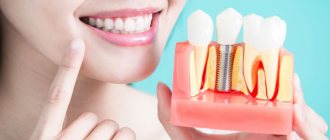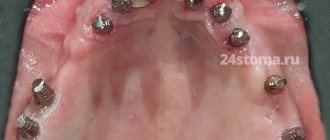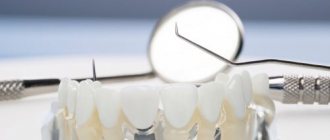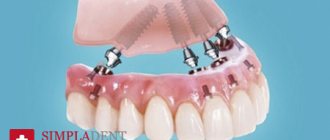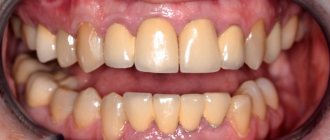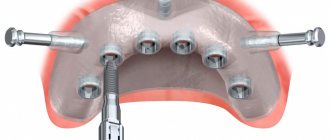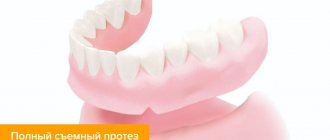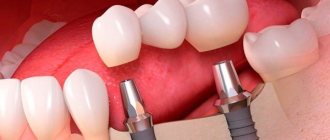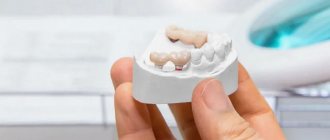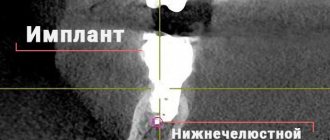Implantation using the All-on-4 method (literal translation “all on four”) allows you to restore the teeth of one jaw on 4 implants in 1 day: 2 outer titanium rods are installed at an angle of up to 45 degrees, bypassing the maxillary sinuses on the upper jaw and the exit site of the nerve on the lower jaw. There is no need to perform additional osteoplastic operations. It is possible to restore teeth in the shortest possible time - immediately after the operation a temporary fixed prosthesis is installed.
Who is All-on-4 suitable for?
- People who have no teeth or very few teeth left.
- For periodontal disease (periodontitis) of all teeth.
- Patients who want to avoid bone grafting.
- For those who want to get new teeth in 1 day.
Stages of implantation using the All-on-4 method
- Initial consultation. During the first meeting, the implantologist conducts a comprehensive diagnosis of the condition of the patient’s oral cavity and jaws. An individual treatment plan is drawn up. Possible options for installing implants and subsequent prosthetics are being considered.
- Installation of implants. It is possible to remove teeth and install artificial roots in one visit.
- Fixation of a fixed orthopedic structure supported by implants.
3-6 months after jaw prosthetics using the All-on-4 method, the relief of the soft tissues of the oral cavity changes, and a space appears between the prosthesis and the gum. Therefore, the temporary orthopedic structure is repositioned or replaced with a permanent one made of zirconium dioxide or metal ceramics.
The 2 outermost implants are installed at an angle to bypass the maxillary sinuses in the upper jaw and the mandibular nerve.
Contraindications
Relative contraindications to all on 4 implantation are inflammatory diseases of the oral mucosa and caries. After sanitation, implants can be installed.
It is strictly forbidden to do prosthetics using this method if the patient is diagnosed with:
- oncological processes in the body;
- blood diseases;
- inflammation in the acute phase of any localization;
- diabetes;
- drug addiction;
- tuberculosis;
- exacerbation of mental pathology.
Teeth in 1 day. Myth or reality?
Implantation with a single-stage load using the All-on-4 technique has been used for more than 20 years, but many people have distrust of the technique, as they consider it a “marketing ploy.” What is really real according to the All-on-4 method and what is not?
Is simultaneous loading harmful to implants?
It is necessary to distinguish between the following concepts:
- Single moment load.
- Early load.
- Delayed loading.
According to studies, after installing a titanium pin, its stability first decreases, and then begins to increase and reaches the required values after 3 months in the lower jaw and after 6 months in the upper jaw. Delayed loading is carried out exactly during these periods. This is the classic and most common method of prosthetics on implants.
The most critical period is from two weeks to two months after installation. It is at this time that the stability of the implant decreases and new bone tissue begins to form. Loading implants at this time poses the greatest risks. But when installing a prosthesis immediately after implantation or within a week after it, the implants are still stable in the bone, so the load will not harm them in any way.
It is worth noting that the simultaneous load of the entire jaw is more predictable than the simultaneous load of one implant. Because a fixed prosthesis connects titanium rods, eliminating dangerous lateral forces that could dislocate a single titanium screw with a temporary crown. But this does not mean that you should immediately use the immediately installed prosthesis as if you were using your own teeth. For the first two months, it is recommended to eat only soft and crushed food, then you can start eating regular food, but be sure to cut it into small pieces with a knife, and only from the fourth month (with implantation of the upper jaw) begin to chew your usual food.
Second question: how is a fixed prosthesis installed immediately after implantation?
In order for the prosthesis to be installed immediately after the installation of implants, a preliminary visit to the dentist is necessary. Before installing artificial roots, impressions are taken of both jaws. Based on the casts, models are made (plaster copies of teeth and jaws), on which the future prosthesis is modeled. Holes are created in it where the implants will approximately be installed. The implantologist can also use such a prosthesis as a template for placing implants. After implantation, temporary abutments or multi-unit abutments are installed, depending on what type of prosthesis fixation will be used (cement or screw). The prosthesis is installed on the abutments, and relining is carried out in the area of the holes. Thus, the prosthesis is fixed to the implants.
The advantages of this method are that the prosthesis is installed immediately after implantation. But if the operation is planned with the simultaneous removal of teeth, then this will affect the accuracy of the prosthesis, because The impressions for its production will be taken while the teeth are not yet removed. This will lead to the fact that the prosthesis in these places will be made approximately, and a lot of relining will be required. Also, the position of implants immediately after tooth extraction cannot be predicted with the same accuracy as in an edentulous jaw.
An alternative option is to take impressions immediately after implantation, make a prosthesis and fix it in 1-7 days. This variation in time is not related to the time of manufacture of the prosthesis, because this can be done quite quickly, and with the appearance of gum swelling, which disappears just on the 7th day.
The advantages of this method are that the prosthesis is made more accurately, because The position of the implants and the gingival contour are already clear. Fixation of the prosthesis on the 7th day immediately after removal of the sutures. The disadvantage of this approach is that you will have to go without teeth for 7 days.
To install a fixed prosthesis immediately after implantation, it is made in advance with holes for abutments. After implantation, the prosthesis is relined and fixed to the implants.
Prosthetics with permanent dentures
Prosthetics is the protection of teeth and restoration of lost elements based on removable and fixed dentures.
Prosthetics after All-on-4 with permanent dentures
Permanent dentures on implants are conditionally removable artificial teeth made of acrylic (plastic), nylon or metal-ceramics or fixed dental bridges. They fit tightly to the gums, replacing missing ones. Permanent dentures are attached to implants (4 or 6 pieces).
What types of dentures are there on implants?
- complete dentures (full set) - which replace all of your upper or lower teeth;
- partial dentures - replacing just 1 tooth or several missing teeth.
Advantages of prosthetics on four implants
The method has been used for a relatively short time, but the technology has a number of undeniable advantages: 1. Prices for dental prosthetics on four implants are much lower.
2. The patient can save a lot.
3. No sinus lift required
4. It is possible to carry out implantation with immediate loading and immediately secure the dentures in the oral cavity.
5. There is no fear that dentures will fall out;
6. When using implants, the service life of the dental prosthesis itself increases by approximately 2-3 times.
Adaptive and permanent type of dentures with complete edentia - what is the difference
An adaptive prosthesis is considered temporary, but it can be worn even for more than 3 years.
The adaptive structure is placed in order to form a correct bite and correct the functioning of the jaw joints.
Good orthopedist for All-on-4 prosthetics
Orthopedist Ostapenko Yu.V.,
Orthopedist - Ostapenko Yuri Vladimirovich - highly qualified.
Orthopedist specialization
Prosthetics on implants, All-on-4, crowns, veneers, bridges, clasp dentures, etc.
Education
In 1985 he graduated from SSMU (Arkhangelsk) with a degree in Dentistry. D
iplom - internal combustion engine 0589821.
In 1986, he completed an internship at the Velsk Central Regional Hospital, specializing in therapeutic dentistry.
Types of dental prosthetics on implants
Prosthetics on implants
Clasp prosthetics on 2 implants
Types of fastenings:
- Clasps - using special hooks.
- Attachment - the structure resembles a snap button, which reliably fixes the entire structure.
- Telescopic dentures look the most natural of all clasp dentures.
Partial dentures are made on 2 implants
A partial denture is designed to fill the gaps left by one or more missing teeth. It is usually attached to some of your natural teeth using metal clips that hold it securely in your mouth. If necessary, 2 implants are placed and prostheses are attached to them.
A partial denture includes crowns that are placed on implants on either side of the gap and connected by false teeth that are inserted into the gap. This design is called a dental bridge or dental bridge on implants. In this case, there should always be an even number of implants, 2 or more. A removable prosthesis on 2 implants with attachments is used in cases where there is not enough bone tissue to install 4.
Prices for clasp dentures in Kaliningrad
- Clasp clasp prosthesis from RUB 28,500.
- Clasp combined prosthesis (metal + monomer-free plastic) from RUB 42,800.
- Clasp prosthesis with locking fastening on two supporting elements from RUB 43,900.
Dental implantation in Kaliningrad reviews
Complete dentures on 4 or 6 implants
A complete denture will be fitted if all of your upper or lower teeth need to be removed (edentulous) or if you need to replace an old full denture.
Before installing a permanent prosthesis, the stability of the implant is tested to avoid unnecessary complications.
Removable overdentures
In removable prosthetics on implants, a cover-type prosthesis with spherical attachments that will completely cover the palate is usually fixed on four titanium implants.
Dentures without a palate for removable prosthetics on implants in the complete absence of teeth can be fixed using micro-locks, locators, or a beam.
The maximum strength of fastening is provided by a beam in a removable prosthesis, but the price of the prosthesis is equal to the cost of a fixed bridge (for example, made of metal ceramics).
Fixed dentures for the upper jaw
Fixed prosthetics on implants in the upper jaw require the installation of six to eight implants. The exact number of implants for prosthetics is selected based on the condition of the bone tissue and jaw.
While the implants are healing, the patient is given a temporary prosthesis made of polymer material. Prosthetics on implants (all on four) can also be conditionally removable. In this case, implants with screw fixation (abutment) are used.
Fixed prosthetics completely imitate their own teeth and are liked by Patients psychologically.
The bone tissue of the upper jaw is less dense, therefore, for complete prosthetics, more implants are often placed on implants - from 4 to 8, and the production time for a permanent prosthesis is extended to 6 months.
Fixed prosthetics of the lower jaw
Fixed prosthetics of the lower jaw is carried out on 6 implants or using the all-on-4 method, but in this case 2 of the 4 implants are placed at an angle of up to 45 degrees.
The service life of a temporary plastic prosthesis is 1 year. Then it is replaced with a permanent non-removable metal-ceramic or zirconium implant after complete healing of the implants. The implants themselves are not affected.
Fixed dentures are popular because of the feeling of having your own teeth that stand firmly in your mouth (psychological effect).
How much do individual implant dentures cost in the region?
- The cost of an acrylic denture in Kaliningrad starts from 11,000 rubles for a partial denture, and from 12,000 rubles for a full jaw denture.
- The cost of a nylon prosthesis is from 25,000 rubles.
- The cost of clasp prosthetics starts from 43,000 rubles: the cost depends on the type of fixation - clasps (hooks) or locks.
- Metal-ceramic crowns without a promotion start in Kaliningrad from - 8,300 rubles.
Prosthetics on implants cost per 1 tooth?
The cost of 1 unit with a metal-ceramic crown on an implant is from 18,900 thousand rubles to 26,600 rubles.
Clasp denture price
Caring for dentures on implants
Dentures may seem a little strange at first, but you will soon get used to them.
When wearing dentures, it is equally important to keep your mouth clean.
It is important to regularly remove plaque and food debris from your dentures.
ADVANTAGES OF BAR CONSTRUCTION OF IMPLANT-BASED DENTURES
1. When installing a beam inside a removable denture, the chewing load is evenly distributed between all implants and the bone
2. The beam is fixed on the implants in the spaces between the metal roots and reliably fixes not only the removable denture, but also the implants (not allowing them to become loose. 3. The beam prosthesis is easy to maintain and allows you to remove the beam and change the design to any other. For example, when moving from temporary to permanent dentures. 4. A fixed and installed denture does not move during meals (when chewing food), therefore it does not cause discomfort to the person and inconvenience when handling the denture. But if necessary, the dentist will always be able to remove the denture from the implants without damage.
Features of complete removable dentures (traditional)
Removable dentures are considered the most economical option.
But the presence of a voluminous artificial palate on the upper jaw and massive gums on the lower jaw causes a feeling of discomfort, nausea and changes in sounds when speaking.
- All chewing pressure spreads to the gums and pain appears when chewing,
- Over time, the gums inevitably develop redness, ulcers, bleeding,
- The prosthesis is poorly fixed on the gums, unlike implants.
Prosthetics using the All-on-4 method
The prosthesis installed on the day of surgery has a service life of 1 year. Then it can be replaced with metal-ceramic or zirconium without affecting the implants. The zirconium prosthesis has no limitations on service life, does not cause allergic reactions and is manufactured using the precise CAD/CAM method (modeling and manufacturing of the prosthesis occurs using computer technology and high-precision milling).
Screw fixation is very popular, when the prosthesis is screwed without the use of cement. This ensures that nothing extra remains under the prosthesis (there will be no excess cement, since there is no cement at all), and the prosthesis can be easily unscrewed by the dentist without damaging the implants and the prosthesis itself.
A properly manufactured screw-retained prosthesis should not be screwed directly to the implants, but to multi-unit abutments, which, in turn, are screwed to the implants. This is the most critical place for the long-term functioning of the implant and prosthetic structure. If the prosthesis is made from the level of implants without abutments, then we are not talking about factory accuracy. In this case, complications arise such as loosening or fracture of screws, inaccurate fit of the prosthesis to the implants, which leads to infection of the junction of the implant and the prosthesis, inflammation and loss of bone tissue, up to the loss of the implant.
What are the advantages of dental prosthetics with 4 implants?
If we compare the “All on Four” technique with the use of removable dentures, the difference will be that in the first case the risks of mucosal injury, bone loss, as well as difficulties with fixation and correction are reduced to zero.
A patient with a removable denture experiences discomfort both functionally and socially. Most people who use removable dentures experience some self-doubt, and sometimes even inferiority in their social status. Also, when installing “all on four” implants, as already mentioned, there is no need for a large number of implants. Due to the fact that these four implants are installed in certain positions in relation to each other: when implanting the front teeth - straight, and in the lateral teeth - at an angle of 35º to 45º, and also by creating a large distance between them, the chewing load is adequately distributed and is redistributed during operation. A small number of implants simplifies the operation, making it faster and more predictable, while ensuring excellent results.
How many implants should I choose?
In addition to All-on-4, there are modifications of this technique. for example, All-on-6 implantation. If there is a sufficient amount of bone tissue, install an additional 1-2 titanium pins, which will significantly reduce the risk of loosening the structure. Don't forget, everything on four can turn into nothing on three. Despite the high percentage of their survival rate (98-99%), one or two percent still sometimes happen. The more implants, the less risks.
The classic All-on-4 technique requires the installation of relatively long implants. Not all patients have enough bone tissue to have them installed without augmentation. In this case, installing shorter models, but in larger quantities, compensates for the insufficient length of the implants.
Do not forget that implantation using the All-on-4 method implies that the load of the teeth of the entire jaw will be carried by only 4 implants. An important factor is the condition of the patients’ masticatory muscles. Four artificial roots are enough for women and older people. Adult men with developed chewing muscles will develop a greater chewing load. In this case, the manufacture of a fixed prosthesis for 4 implants will carry additional risks. Fortunately, with well-developed muscles, the bone tissue of the jaws is also well preserved. This allows you to install an additional 1-2 implants to evenly distribute the chewing load.
Different options for the number of implants in the absence of teeth (from left to right):
- Six implants on each jaw, two on the upper jaw are installed at an angle, bypassing the maxillary sinuses, on the lower jaw there is a classic installation.
- Six implants in the upper jaw and four in the lower jaw, some of them are installed at an angle.
- Four implants in the upper jaw, two are installed at an angle, bypassing the maxillary sinuses.
What implants and prostheses are used?
The “all on 4 implants” prosthetic technology was developed and introduced into global dental practice by the American company Nobel Biocare. Since then, the components of this brand have been considered the standard of quality. However, over the twenty-year period of use of the technique, many worthy analogues have appeared, produced by domestic and foreign enterprises.
Implants
The YuliSTOM dental clinic in St. Petersburg offers a wide range of titanium pins and abutments from different manufacturers for installation. The patient can choose the most suitable option in terms of quality and cost from the following brands:
- Rusimplant are universal orthopedic elements of the ConeFit system, produced in Russia using German technologies. Made of Grade 5 (titanium) alloy, corrosion resistant, highly compatible with biological tissues, lightweight and durable.
- Superline is a Korean middle-class prosthetic system made of Grade 4 alloy with a conical connection type.
- Nobel is the standard of all on 4 implantation components from the technology developer. Design features - different types of threads, a special microporous Ti-Unite surface, ensuring almost 100% engraftment, Grade 4 alloy (ultra-pure titanium).
- Straumann - are distinguished by a unique Roxolid alloy (titanium with zirconium dioxide) and a hydrophilic surface. These features of Swiss pins reduce the time of osseointegration to one and a half months.
- Prodigy is a product of BioHorizons Implant Systems, Inc., USA. They take root well due to the unique Laser-Lok surface and microchannels located on the neck of the titanium root.
- Adin Implant - implants made in Israel, characterized by a relatively low survival rate and outdated design. Made from Grade 5 titanium alloy with aluminum and vanadium.
- Hi-Tec Implant - in terms of properties and design, the products of the Israeli brand are as close as possible to the original Nobel implants. This explains the rather high rates of osseointegration.
The table contains brief basic information about each type of implant:
| Name | Class | Survival rate, % | Guarantee | Price, rub |
| Nobel | premium | 99,3 | for life | 198 000 |
| Superline | average | 98,2 | 120 000 | |
| Straumann | premium | 99,7 | 200 000 | |
| Adin Implant | average | 85 | 90 000 | |
| Hi-Tec Implant | average | 92 | 110 000 | |
| Prodigy | average | 97,5 | 115 000 | |
| Rusimplant | economy | 85 | 15 years | 50 000 |
Prostheses
After selecting the appropriate type of titanium roots, it is necessary to select fixed prostheses on 4 implants, as well as an adaptive (temporary) design. Manufacturers offer four main types of artificial teeth. The best option is metal-ceramic products from the Nobel company, the best acrylic bases are produced by the German brand Heraeus Kulzer, and crowns are produced by the Japanese company Yamahachi.
- Metal-free base with acrylic or zirconium dioxide crowns. The base of the artificial jaw is made of zirconium dioxide, which allows you to evenly distribute the load on the gums and give additional strength to the bridge. However, to reduce the cost of construction, a fiberglass frame lined with ceramics can be used. The product is quite durable - its service life is about 10 years.
- Metal-free crowns made of zirconium dioxide or acrylic. In the first case, the design is more durable and looks as aesthetically pleasing and natural as possible. Artificial teeth made of acrylic are cheaper, but they look less natural and wear out faster (their service life is limited to 5 years).
- Metal ceramics. A metal-ceramic prosthesis with a titanium beam is an expensive option characterized by increased strength. It is indispensable in the case of elongated side consoles of the structure. Among the disadvantages, one can note reduced aesthetics, since the titanium frame gives the ceramic a grayish tint. The cheaper option is not a titanium alloy, but a cobalt-chromium alloy (CHC), but it will weigh more.
- Milled titanium base with acrylic prosthesis. Beam prosthesis on 4 implants, with a hot polymerization plastic base from the German manufacturer Heraeus Kulzer. The base is elastic and impact-resistant. Yamahachi acrylic crowns made in Japan are characterized by increased strength and wear resistance. The milled titanium base ensures uniform load on the jaw.
- Acrylic prosthesis. Orthopedic design made of acrylic obtained by processing under high pressure at high temperatures. This technology will reduce the amount of monomer in plastic and reduce the risk of an allergic reaction. The advantages include a relatively low cost, and the disadvantages are low strength indicators and rapid wear of the crowns.
Which implants are suitable for All-on-4 technology?
The All-on-4 concept was developed by Nobel biocare. But this does not mean that other implants are not suitable for this technique. Most well-known implant systems have all the capabilities for jaw prosthetics based on the All-on-4 or All-on-6 concept. An important condition is the design of the implant, designed for simultaneous loading.
One of the most inexpensive but reliable options would be to use Osstem implants, South Korea. The German implant systems Ankylos and Xive Friadent have proven themselves well. Don't forget about other premium systems Straumann and Astra tech.
Straumann has improved the All-on-4 protocol with the development of the Straumann® Pro Arch concept. The technology is suitable for patients with a toothless jaw; they receive 4-6 implants with immediate fixation of a permanent acrylic prosthesis. Thin implants made of a particularly strong titanium and zirconium alloy, Straumann Roxolid, can withstand heavy loads, and the installation of rods in the lateral sections of the jaw allows implantation to be carried out in cases of bone tissue deficiency.
“All on four”: differences from classical technology
Adentia is divided into two types - partial and complete. Partial implies the absence of a certain number of teeth, complete means a completely toothless jaw. Until recently, in case of complete loss of teeth, the options for reconstructing the dentition included removable prosthetics or the implantation of individual implants instead of each missing tooth. The choice was between an uncomfortable and unesthetic artificial jaw or significant costs for the operation. Everything changed with the advent of new implantation technology, which allows you to restore the entire dentition on 4 implants.
New standard of implantation – minimal invasiveness
The world does not stand still; new research is constantly being conducted in the field of dental implantation. Long-term 10- and 20-year observations of implants functioning successfully in the oral cavity are appearing. Clinical studies show that the thickness and length of the titanium rod are not the main factor in success. Implants of large diameter and length often lead to complications and their lifespan is sometimes shorter. This is due, first of all, to the more traumatic installation of “thick” models.
An important factor in the long-term functioning of artificial roots is the preservation of the patient's own bone through the use of thinner and shorter implants. This also reduces the need for bone grafting because Initially, less bone tissue is needed to completely immerse a thin implant into the bone.
However, thin models from not all manufacturers are able to withstand heavy loads in the area of chewing teeth, or in the absence of teeth. These requirements are met by German Ankylos implants
, as well as Swiss Straumann Roxolid implants.
Ankylos implants have design features that, when installed below the level of bone tissue, allow them to withstand heavy loads even with their small diameter. Roxolid is an alloy of titanium and zirconium, which was developed by Straumann. It is much stronger than just titanium and has the same biocompatibility. Therefore, thin Straumann Roxolid implants can be used in cases where it is necessary to install a larger titanium pin from another manufacturer.
- Minimal invasiveness.
- No bone grafting required.
- Guaranteed results even in complex clinical cases.
Features of the All-on-4 implantation procedure
The traditional All-on-4 procedure boils down to the following:
- After studying the OPTG and CBCT data, the dentist determines the best places to install the DI;
- The operation begins with anesthesia and the formation of a folding mucoperiosteal flap;
- A standard template is applied to the jaw, according to which the doctor determines the places for screwing in titanium supports;
- Two implants are installed in the frontal area strictly vertically in relation to the jaw;
- The remaining two implants with multi-units are installed obliquely at an angle of 35-45 degrees in the lateral areas - one on each side of the jaw;
- The flaps are returned to their places, the wounds are sutured;
- The operation is completed by screw fixation of a temporary acrylic prosthesis to the established DI for up to 6 months;
- After 10-12 days, the sutures are removed and the temporary prosthesis is returned to its place;
- After the period of complete osseointegration of the implants, a complete removable denture (no more than 12 units) is made from acrylic or with a titanium or zirconium bar lined with ceramics. In addition, there are possible options for prosthetics with fixed bridge structures or conditionally removable products with locking fasteners.
The inclination of the DI provides a larger area of contact of the titanium root with the bone, especially with its cortical layer, due to which the future fixed prosthesis will be more stable in the oral cavity, and important maxillofacial structures (maxillary sinus or mandibular nerve) are not affected.
A permanent prosthesis has a base that completely covers gum defects formed due to a long absence of teeth. It is for this reason that there is no need for bone grafting and gingivoplasty (surgery to increase the height of the gums).
More advanced, but also technically complex, is the implantation procedure using an individually modeled 3D surgical template, which is printed and applied to the jaw before the operation. This ensures maximum accuracy of DI placement. The protocol can be performed either with a flap detachment or using a flapless technique, i.e. through gum punctures.
Work examples
How often do you visit the dentist?
Benefits of All-on-4 technology
Installing extreme implants at an angle allows you to bypass anatomically complex formations (maxillary sinuses in the upper jaw and the exit point of the nerve in the lower jaw). This reduces the risks of implantation and reduces the need for osteoplastic procedures. Many studies conducted by scientists around the world, including the International Association of Implantologists - ITI - International Team for Implantology
– showed the validity of this treatment method and recommended it as a reliable option for restoring teeth in one or both jaws.
Myth 2. Immediate loading impairs the healing process of the gums
If “All on 4 implants” prosthetics is used, the adaptive structure can be installed immediately after completion of surgical procedures. This means the patient goes home with new teeth to chew on. And this does not interfere with the healing process. On the contrary, the load helps improve blood supply, lymphatic drainage and local metabolism in the surgical area. However, during the first week you need to follow a special diet and take medications prescribed by your doctor.
Advantages and disadvantages of the method
The main advantage of the “All on 4” method is the reliability of fixation of the prosthesis in the oral cavity. In addition, the patient receives an aesthetic effect and the opportunity to eat fully from the moment the temporary prosthetic structure is installed. This technology significantly reduces trauma and stress on the body, because only 4 implants need to be implanted for one jaw, and not 10 - 12 titanium rods. This factor allows you to minimize the cost of implantation. Another advantage is the ability not to undergo osteoplasty (bone grafting) in case of minor or moderate bone atrophy. Rapid adaptation to the prosthesis also plays an important role. The patient does not feel the orthopedic structure as something foreign, chewing does not cause him discomfort, and diction does not change. A big bonus is the even distribution of the load on the jaw bone when chewing. This allows you to prevent the progression of its resorption (resorption).
The method does not have many disadvantages. For example, this technology cannot be implemented if the structure of bone tissue is excessively loose or if it is critically deficient. To be fair, it is worth noting that this is a contraindication for the use of any implantation technology. In such situations, it is necessary to perform preliminary bone grafting, i.e., increasing the volume and increasing the density of the bone.
